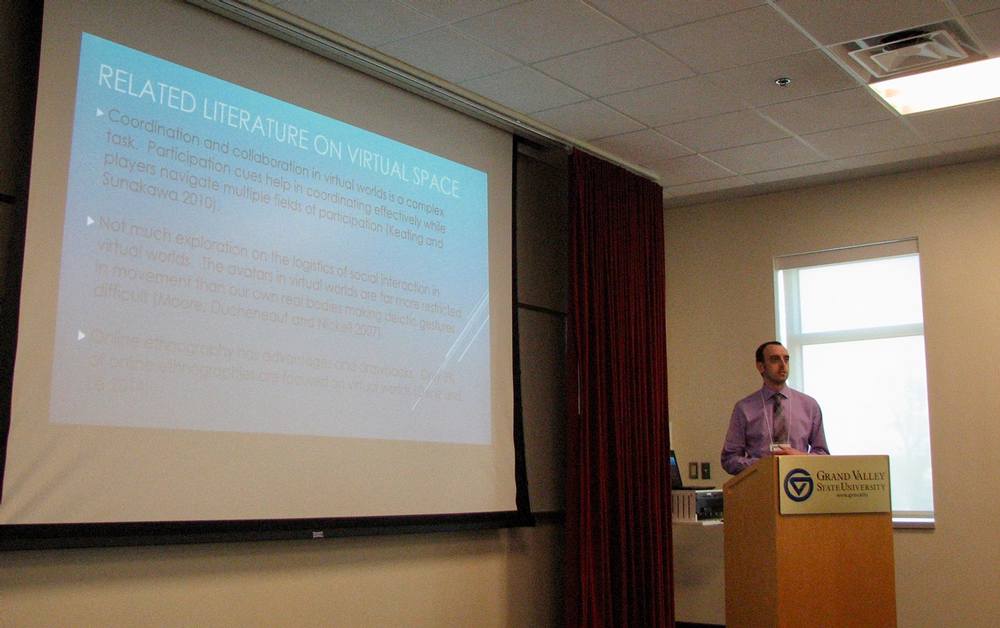News
Anthropology at Student Scholars Day
April 18, 2018

Student Scholars Day is held once each year to showcase faculty-mentored student work, including oral presentations, discussion and panel sessions, fine arts exhibits and performances, and poster presentations. Below are the 2018 anthropology contributors
Social Science: Issues in Undergraduate Enrollment
Presenter: Andra Durham
Mentor: Tara Hefferan
As STEM fields continue to grow across the United States, social
sciences, including anthropology, have begun seeing a downward shift
in the number of undergraduate enrollments. This is also true at GVSU,
where the Fall 2017 ANT420 class wanted to know why it is, in an age
when anthropology thrives in its ability to bridge the cultural
distance in an ever more subtly connected global society, than student
enrollment has begun to decrease. To answer this, a study was designed
and conducted over eight weeks by the ANT420 students, gathering
perspectives on the field of anthropology and individual enrollment
choices of non-majors and majors alike through a questionnaire and
focus groups, as well as those of the anthropology faculty, to gain
insight and suggest solutions. Findings suggest the field itself is
misunderstood by students and that enrollment would benefit from more
visibility and cross-departmental engagement to focus on the
interdisciplinarity of anthropology.
Tradition on Display: Graphically Representing Maasai
Medicinal Ethnobotany In Kenya
Presenter: Anthea Mitchell
Mentor: Kristin Hedges
As a supplement to ongoing work being done by Dr. Kristin Hedges with a Maasai community in Kenya, this poster is meant to fulfill a need expressed by older members of the tribe there. Due to the spread of biomedicine and changing lifestyles, the customs surrounding the use of traditional plants have changed. Previously, local plants were used to treat specific ailments, and also --perhaps more importantly -- to maintain individual and family health and strength. This use played a role in the identity of individuals as part of that community. There is an expressed concern that the knowledge of these plants and use of traditional medicines is being lost and, with that, protection over valuable resources. This visual guide to important plants identified by members of the community offers both the Maasai names and accompanying sample photos. It was made to take advantage of a cultural preference; many households in this region are inclined to use posters as décor. Traditional beadwork and illustrations will ideally improve the aesthetic appeal as ornamentation, and perhaps double as an aid in plant identification. In conjunction with other work, it is intended to act as one possible step towards cultural preservation.
Referential Spatialization and Collaborative Communication in
Virtual Space
Presenter: Alexander Norris
Mentor: Michael Wroblewski
Non-verbal communication is an integral part of everyday communication. However, in ever-growing, online gaming communities worldwide, non-verbal communication is severely restricted, rendering many tasks complex and difficult. I examine the ways a specific community of gamers implement in-game tools in communicative practices. Of particular interest is how players use these tools to spatialize objects/places of interest in relation to players’ in-game avatars. This study consists of video- and audio-recordings of conversational data between eleven members of the Xbox Live community. I argue that the number call-outs used by players with the help of an in-game compass act as unique verbal gestures. The number call-outs act as both deictic gestures, pointing to whatever a speaker finds relevant, and as regulatory gestures used to control and coordinate interaction. In using these numbers, players are able to more articulately communicate and spatialize themselves in virtual space.
Stress Indicator
Presenter: Sam LoPresto
Mentor: Gwyn Madden
As one
ages the experiences that they have and the tribulations they endure
become encoded on an individual’s osteology. These events can cause
manifestations of non-specific stress indicators. More specially when
an individual has stress occur in development it can affect the
eventual growth of the transverse neural canal. Previous studies
(Watts, 2011) have shown that mortality occurs towards those that have
a smaller transverse neural diameter. Two different populations were
used to compare different environmental influences and how these could
affect the vertebra throughout life and development. A Neolithic
sample from Verteba Cave, located in Western Ukraine, was compared
with an Iron Age population from the United Kingdom. The results of
this study show a significant difference in the neural canal size.
